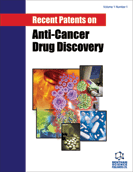
Abstract
Cisplatin, carboplatin and oxaliplatin continue to be among the most efficient anticancer drugs in world-wide clinical use so far. In particular, cisplatin has shown a remarkable therapeutic efficacy in a broad spectrum of solid tumors and outstanding activity against metastatic testicular germ-cell cancer with cure rates of about 90% of cases. Nevertheless, the dose-limiting severe toxic side-effects of platinum-based chemotherapy, the problem of inherent or therapy-induced resistance, the limited activity in a range of tumors, and the meager tumor selectivity are the motivation for tremendous efforts and inventions in the development of novel anticancer platinum drugs. This article reviews the most recent patents in this field of research, covering the following strategies in the design of promising anticancer platinum complexes: (i) synthesis of new anticancer platinum complexes, using combinatorial chemistry and high throughput synthesis and screening, (ii) activation of platinum complexes in the tumor tissue, (iii) accumulation of platinum complexes at the tumor site, (iv) novel platinum complexes, displaying activity against cisplatin resistant cells and as inhibitors of specific biological functions, and (v) direct derivatives of classical anticancer platinum drugs in clinical use.
Keywords: platinum complexes, cisplatin, carboplatin, oxaliplatin, synthesis, novel derivatives, combinatorial chemistry, high throughput synthesis and screening, reduction of side-effects, activation
Recent Patents on Anti-Cancer Drug Discovery
Title: Recent Developments in the Field of Anticancer Platinum Complexes
Volume: 1 Issue: 2
Author(s): Mathea Sophia Galanski*
Affiliation:
- Institute of Inorganic Chemistry – Bioinorganic, Environmental and Radiochemistry, University of Vienna, Vienna, Austria
Keywords: platinum complexes, cisplatin, carboplatin, oxaliplatin, synthesis, novel derivatives, combinatorial chemistry, high throughput synthesis and screening, reduction of side-effects, activation
Abstract: Cisplatin, carboplatin and oxaliplatin continue to be among the most efficient anticancer drugs in world-wide clinical use so far. In particular, cisplatin has shown a remarkable therapeutic efficacy in a broad spectrum of solid tumors and outstanding activity against metastatic testicular germ-cell cancer with cure rates of about 90% of cases. Nevertheless, the dose-limiting severe toxic side-effects of platinum-based chemotherapy, the problem of inherent or therapy-induced resistance, the limited activity in a range of tumors, and the meager tumor selectivity are the motivation for tremendous efforts and inventions in the development of novel anticancer platinum drugs. This article reviews the most recent patents in this field of research, covering the following strategies in the design of promising anticancer platinum complexes: (i) synthesis of new anticancer platinum complexes, using combinatorial chemistry and high throughput synthesis and screening, (ii) activation of platinum complexes in the tumor tissue, (iii) accumulation of platinum complexes at the tumor site, (iv) novel platinum complexes, displaying activity against cisplatin resistant cells and as inhibitors of specific biological functions, and (v) direct derivatives of classical anticancer platinum drugs in clinical use.
Export Options
About this article
Cite this article as:
Galanski Sophia Mathea*, Recent Developments in the Field of Anticancer Platinum Complexes, Recent Patents on Anti-Cancer Drug Discovery 2006; 1 (2) . https://dx.doi.org/10.2174/157489206777442287
| DOI https://dx.doi.org/10.2174/157489206777442287 |
Print ISSN 1574-8928 |
| Publisher Name Bentham Science Publisher |
Online ISSN 2212-3970 |
 35
35
- Author Guidelines
- Graphical Abstracts
- Fabricating and Stating False Information
- Research Misconduct
- Post Publication Discussions and Corrections
- Publishing Ethics and Rectitude
- Increase Visibility of Your Article
- Archiving Policies
- Peer Review Workflow
- Order Your Article Before Print
- Promote Your Article
- Manuscript Transfer Facility
- Editorial Policies
- Allegations from Whistleblowers
Related Articles
-
microRNAs: Small Molecules with a Potentially Role in Oral Squamous Cell Carcinoma
Current Pharmaceutical Design The Complexities of TGF-β Action During Mammary and Squamous Cell Carcinogenesis
Current Pharmaceutical Biotechnology Screening Novel SAHA Derivatives as Anti-lung Carcinoma Agents: Synthesis, Biological Evaluation, Docking Studies and Further Mechanism Research between Apoptosis and Autophagyetween Apoptosis and Autophagy
Anti-Cancer Agents in Medicinal Chemistry Involvement of Targeting and Scaffolding Proteins in the Regulation of the EGFR/Ras/MAPK Pathway in Oncogenesis
Current Signal Transduction Therapy Rapidly Increasing Trends in Oropharyngeal Carcinoma Assessed by Worldwide Epidemiologic Analysis
Current Cancer Therapy Reviews The Role of EGFR-Met Interactions in the Pathogenesis of Glioblastoma and Resistance to Treatment
Current Cancer Drug Targets Novel Agents in the Management of Lung Cancer
Current Medicinal Chemistry Emerging Role of the Ubiquitin-proteasome System as Drug Targets
Current Pharmaceutical Design Spherical Self-Organizing Map Detects MYBL 1 As Candidate Gene for Triple-Negative Breast Cancer
Neuroscience and Biomedical Engineering (Discontinued) From Concept to Reality: The Long Road to c-Met and RON Receptor Tyrosine Kinase Inhibitors for the Treatment of Cancer
Anti-Cancer Agents in Medicinal Chemistry Role of Genetic and Epigenetic Factors in Oral Squamous Cell Carcinoma - A Structured Review
Recent Patents on Biomarkers Liquid Chromatographic Analysis of Methotrexate and Minocycline-relevance to the Determination in Plasma/Nanoparticulate Formulations
Current Chromatography Ruthenium Complexes as Anticancer Agents
Current Medicinal Chemistry Design, Synthesis, and In Silico Studies of Novel N-(2-Aminophenyl)-2,3- Diphenylquinoxaline-6-Sulfonamide Derivatives Targeting Receptor- Binding Domain (RBD) of SARS-CoV-2 Spike Glycoprotein and their Evaluation as Antimicrobial and Antimalarial Agents
Letters in Drug Design & Discovery New Generation of Oncolytic Herpes Virus
Current Cancer Therapy Reviews Ceramidases in Hematological Malignancies: Senseless or Neglected Target?
Anti-Cancer Agents in Medicinal Chemistry Anti-Tuberculosis Drug Induced Hepatotoxicity and Genetic Polymorphisms in Drug-metabolizing Genes
Current Pharmacogenomics Cancer Proteomics: New Horizons and Insights into Therapeutic Applications
Current Proteomics Specific Hemosiderin Deposition in Spleen Induced by a Low Dose of Cisplatin: Altered Iron Metabolism and Its Implication as an Acute Hemosiderin Formation Model
Current Drug Metabolism The Ubiquitin-Proteasome System (UPS) and the Mechanism of Action of Bortezomib
Current Pharmaceutical Design


























